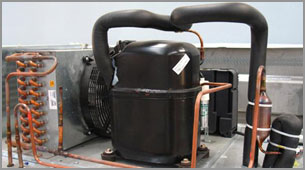Troubleshooting
All Commercial Freezers have similar and basic components that are common. For example, all freezers will have a compressor, condenser, and evaporator.
AND all commercial freezers will also have similar and basic reoccurring problems. Most of these problems are user or consumer related. Here is a list of the most common reoccurring problems:
- Lack of Maintenance
- Iced Coil
- Power Issues
- Bad Start Components
Iced Coil
Sometimes an iced coil is obvious as in the pictures below - in these pictures, the ice has built up past the coil, spread past the evaporator fans and into the interior of the cabinet. Often times after ice build up the first symptoms will be a "tinging" noise which is the fan blade hitting the ice. Also, the temperature in the cabinet will drop somewhat but usually remain consistent within a degree or two - until the situation intensifies whereas the unit will no longer operate as it should. Sometimes the ice will build so bad that it will damage the evaporator fan motor, fan blade, or possibly even the coil itself - often times the expansion of ice will damage the fins of the fan blade and possibly create a whole in the coil itself.
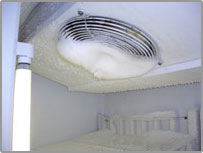
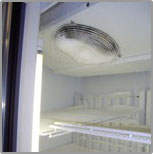
Sometimes the ice is only built on the coil itself and may be difficult to see without removing the evaporator cover. DO NOT remove the evaporator cover!
We do recommend however taking a mirror to the back of the unit (behind the cover that protects the fans there is often times a 2-5" gap allowing room to see the coil with a properly positioned mirror) Merely placing a mirror in position to see the coil will often reveal if ice build, frost, or snow up is present on the fins. DO NOT stick your hand up there for a feel if you do not know where to look as there are electrical components, defrost heaters, and fan motors that could hurt you.
How To Properly Maintain Your Commercial Freezer
Freezer Maintenance
Freezer maintenance is critical to help extend the life of your investment. A freezer is similar to your car in that it will require maintenance in periodic and frequent intervals. The frequency of intervals is dependent upon the freezers usage, it's general location, and the environment it is kept. Irregardless, maintenance should be scheduled: annually, quarterly, or monthly and adhered to as LAW.
The maintenance is simple and can easily be performed by the consumer or a hired hand. If however you are unable or unwilling to commit an employee to this, I strongly recommend to my customers that they sign up for a schedule PM (preventive maintenance) program.
When I do a PM I actually take the time to record the make, model, and serial number of each unit I am working on. I have a check list if you will with the items I examine and clean. I record all of this on my PM card as well and as document any items I noticed that may need attention. I record these PM's on file in my data base and also mail a copy to the customer for their records. I view this as an insurance policy or "peace of mind". The term "PM" traditionally stands for "Preventive Maintenance" but I also like it to mean "Peace of Mind"
Common and easy maintenance steps for ALL freezer owners
Freezer Maintenance tip #1:
MOST IMPORTANT: The condensing unit (typically found underneath or above self contained units) must be cleaned on a regular and consistent basis. This can be easily done with a vacuum cleaner, compressed air, or water depending on the freezers location in your facility. I prefer to clean the condensing unit with a power washer but I have the liberty of a nice work shop and need not worry about the floor, surroundings, etc. The idea is to remove the "dust bunnies" from the fans, compressor, and condenser (the radiator looking thing in front of the fans)
IMPORTANT NOTE WHEN USING COMPRESSED AIR: I have found over the years that many people are under the impression to take an air nozzle to blow the dust bunnies through the condenser. DO NOT DO THIS!
I cannot emphasize enough how ridiculous this is. For one, 9 times out of 10, the end results actually plugs the fins in the condenser as the "dust bunnies" collect in-between the fins rather than push through them. Furthermore, the ones that do pass through end up on the fan(s) behind the coil and go all over the compressor as well.THIS IS INSANE!
The analogy I use here is this: remember when you were a kid and you mom told you to quit sniffling? She would then hand you a tissue and tell you to blow it out - get rid of it!
So, if you insist on using compressed air, blow the stuff out not in! WARNING: Be prepared though, when you blow it out, the dust bunnies will obviously go all over your building in a huge cloud! For this reason, I recommend using a vacuum in tandem with the compressed air. Suck the mess up and get rid of it!

Electrical Wiring for Freezers
PLEASE NOTE: A licensed electrician should be retained and used to wire any circuits supplying power to a commercial freezer. Severe and permanent damage will result from improper wiring of your freezer!
What is the Electrical Rquirements for My Merchandiser?
It is imperative to check the voltage and amp draw to determine proper line and fuse or circuit breaker size. This information is obtainable via the Data Platefound inside the unit. Check power supply for low voltage. If voltage reads "230" with no load, and it drops below "207" when the compressor tries to start, it is an indication of too small of a supply wire or possibly too long of a run. It is imperative that a separate circuit be run for each cabinet to prevent another appliance blowing the fuse of breaker, or loss due to low voltage from an overloaded circuit.
What is the Plug Type Needed for A Freezer
Most 2 and 3-door self contained (low temp) freezers will have and come with a NEMA L14-20P twist lock plug. This is a 20 amp plug but interestingly reads 125/250 volt on it. The cabinet must be grounded.
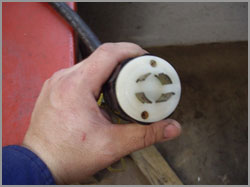
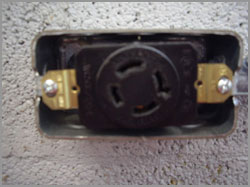
Can This Plug Utilize A 3 Wire System?
The quick and simple answer is NO! Most manufacturers have a 4-wire system. There should be a red wire and a black wire (power legs - hot), a white wire - which is the neutral, and a green wire - which is the ground. The ground will have a "L" shape to it on the plug configuration. It is important to note; when wiring the plug, the "L" shape - ground leg is the green wire, the opposite leg will be the white - neutral leg. The other two legs will be the "hots" - black and red.
Can I Wire The Neutral To The Ground?
Although it is possible and the unit should still work. DO NOT DO THIS! By wiring the neutral and the ground together, it eliminates the use for the run capacitor and will cause and create "hard" starts for the compressor. This will reduce the life of the compressor and reduce.
*NOTE: I have just recently experienced a couple of clients who have indirectly encountered this. Although my client hired a licensed electrician and informed him what I mentioned regarding the requirements of the unit, the electrician, in the breaker panel, wired the ground and neutral into the ground bar - he did not separate them for reasons I cannot explain. And, in this case, the first unit tanked the compressor as well as the replacement unit I brought them. IT IS IMPERATIVE TO KEEP THE GROUND AND NEUTRAL ISOLATED AND SEPARATE!
Heating and Cooling FAQS
Q: What does HVAC mean?
A: HVAC stands for heating, ventilation and air conditioning, and generally refers to the heating and cooling system. The system can control temperature, humidity, the intake of fresh air and is responsible for maintaining the air quality of your space.
Q: Why should you invest in a new heating or cooling system?
A: After a thorough one-on-one consultation to determine your business’ needs and assess your current building and equipment, a StayKool Mechanic can suggest the HVAC package that best meets your needs. We know that in choosing your equipment, the most important consideration is meeting your individual needs, such as identifying the highest efficiency units to reduce energy consumption to save you money in the long run. Packages will be recommended based on improving performance and optimizing efficiency. Your building and roof structure are also important factors in determining the best choice of equipment for you. Contact your expert heating and cooling company.
Q: What is the standard lifetime of a unit?
A: The lifetime of a unit depends on the date of manufacture, the quality of the equipment and the historical care (i.e. service and maintenance) of a unit. Because they do not have moving parts, gravity types and floor furnaces appear to have the longest life, usually lasting 50-60 years. Forced air furnaces have a 15-18-year long life expectancy, while air conditioners typically last 15-20 years. As the units become older, they tend to require frequent repairs.
Q: Should I replace or repair my current system?
A: If the system has been kept clean, it might be worth repairing it. However, the cost of cleaning an old, poorly maintained furnace can be costly, making replacement the more practical option.
Q: How often should I service my unit?
A: You should have your system serviced by an experienced technician at the start of every season. This ensures that your unit is functioning properly, eliminating the possibility of a minor issue developing into a major problem, such as a costly motor repair or a blown compressor. Count on StayKool Mechanical to meet all of your service and maintenance needs.
Q: Why am I seeing black/brown streaks on my wall around the vents?
A: While black or brown streaks on your wall could just be a sign of dirty air in the space, they could also indicate a crack in the fibrox inside your furnace. This can result in carbon monoxide leakage, poisoning your air. In this event, the system should be shut off and carefully checked for safety. StayKool Mechanical has the expertise required to deal with this and other hazardous heating and cooling issues.
Q: Why can I smell my furnace heating up?
A: The odor you detect is the dirt burning off your furnace’s heat exchanger. Small particles of dirt settle on the firebox and burn off with each use. To eliminate this issue, improve your filtration system and clean out the system. For more information, call StayKool Mechanical today!
